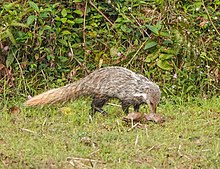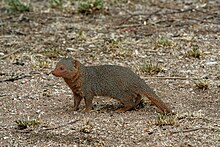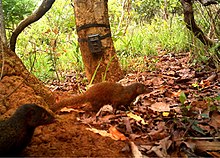Мунгоси (породица)
| Мунгоси[1] | |
|---|---|

| |

| |
| разни представници породице Herpestidae | |
| Научна класификација | |
| Домен: | Eukaryota |
| Царство: | Animalia |
| Тип: | Chordata |
| Класа: | Mammalia |
| Ред: | Carnivora |
| Подред: | Feliformia |
| Инфраред: | Aeluroidea |
| Парвред: | Viverroidea |
| Натпородица: | Herpestoidea |
| Породица: | Herpestidae Bonaparte, 1845 |
| Типски род | |
| Herpestes Illiger, 1811
| |
| Потпородице | |

| |
| распрострањеност породице | |
| Синоними | |
|
листа синонима:
| |
Мунгоси (лат. Herpestidae) породица су из подреда мачколиких животиња. Насељавају континенталну Африку и јужну Евроазију. Ова породица је тренутно подељена на две потфамилије, Herpestinae и Mungotinae. Herpestinae обухвата 23 живе врсте које су пореклом из јужне Европе, Африке и Азије, док Mungotinae обухвата 11 врста које потичу из Африке. Мадагаскарски мунгоси из потпородице Galidiinae, која је ендемит Мадагаскара, су се са афроазијским мунгосима налазили у истој породици. Међутим, након анализа ДНК су смештени у породицу Eupleridae. Породица Herpestidae је настала пре око 21,8 ± 3.6 милиона година година у раном миоцену и генетски се разишла у две главне генетске лозе пре 19.1 и 18,5 ± 3.5 милиона година.
Претпоставља се да постоји блиска сродност између цибетки и мунгоса.
На острва јужног Јадрана мунгос је насељен почетком 20. века.
Једна од боље проучених врста из ове породице су меркати (лат. Suricata suricatta). Они су настањени у Јужној Африци и у полупустињским пределима. Домороци их називају „човечуљцима”. Живе у подземним стаништима, у већим групама.[2][3]
Етимологија назива[уреди | уреди извор]
Назив ове породице води поријекло од типског рода Herpestes и таксономски наставка -idae. Енглеска реч "мангус" се писала као "мунгос" у 18. и 19. веку. Име је изведено од назива који се у Индији користи за врсте Herpestes[4][5][6][7]: muṅgūs или maṅgūs на класичном хиндију;[8] muṅgūs на маратхију;[9] mungisa на телугу;[10] mungi, mungisi and munguli на канадски језик.[11]
Опис[уреди | уреди извор]
Мунгоси су дугачки до jednog метрa заједно са репом (24 до 58 cm без репа). Они теже од 320 g до 5 kg.[12] Мунгоси имају дуга лица и тела, мале округле уши, кратке ноге, и дуге шиљате репове. Своје неувлачеће канџе користе се првенствено за копање. Мунгоси, попут коза, имају уске, овуларне зенице. Већина врста има велику аналну мирисну жлезду која се користи за територијално обележавање и сигнализацију репродуктивног статуса. Зубна формула мангоса је 3.1.3–4.1–23.1.3–4.1–2.
Мунгос је хитар је и неумољив: упоран је и никада не оставља свој плен. Мунгос је најпознатији непријатељ страшне и опасне кобре. Без страха јој се супроставља и из двобоја са њом обично излази као победник. Мунгос вешто и хитро избегава отровне зубе змије све док она не скочи на њега. Тада мунгос успева да је зграби за потиљак. Заштићен је својом дебелом кожом и крзном. Египатски мунгос је био света животиња у доба фараона, па су у пирамидама пронађене и мумије мунгоса. Многе врсте мунгоса живе поред човека, како корисне кућне животиње које уништавају пацове и змије, иако понекад нападају и домаће животиње — куниће и живину.
Мунгоси имају рецепторе за ацетилхолин који су, попут рецептора код змија, оликовани тако да се змијски неуротоксин из венома не може везати за њих. Мунгоси су један од четири позната таксона сисара са мутацијама у никотинском ацетилхолинском рецептору које их штите од змијског венома.[13] Њихови модификовани рецептори спречавају везивања α-неуротоксина из змијског отрова. Ови рецептори имају четири засебне, независне мутације. Код мунгоса, ова промена је доводи до јединствене гликозилације.[14]
Систематика[уреди | уреди извор]
Herpestina је било научно име које је предложио Шарл Лусјен Бонапарта 1845. године, који је сматрао да су мунгоси потпородица породице Viverridae.[15] Године 1864, Џон Едвард Греј је класификовао мунгосе у три потфамилије: Galiidinae, Herpestinae и Mungotinae.[16] Ово груписање је подржао Реџиналд Покок 1919. године, који је називао фамилију Mungotidae.[17]
Генетичка истраживања базирана на анализама једрене и митохондријске ДНК показала су да су Galidiines сроднији са мадагаскарским месождерима, укључујући фосу и фаналоку.[18][19] Galiidinae се тренутно сматра потфамилијом фамилије Eupleridae.[20]
| Подпородица | Род | Врсте | Слика типске врсте |
|---|---|---|---|
| Herpestinae | Herpestes Illiger, 1811[21] |
|

|
| Atilax Cuvier, 1826[27] | Мочварни мунгос (A. paludinosus) (Cuvier, 1829)[28] | 
| |
| Cynictis Ogilby, 1833[29] | Жути мунгос (C. penicillata) (Cuvier, 1829)[28] | 
| |
| Urva Hodgson, 1836[30] |
|

| |
| Ichneumia Geoffroy Saint-Hilaire, 1837[36] | Белорепи мунгос (I. albicauda) (Cuvier, 1829)[28] | 
| |
| Bdeogale Peters, 1850[37] |
|

| |
| Rhynchogale Thomas, 1894[43] | Мелеров мунгос (R. melleri) Gray, 1865[16] | 
| |
| Paracynictis Pocock, 1916 | Селусов мунгос (P. selousi) (de Winton, 1896) | 
| |
| Xenogale Allen, 1919[44] | Дугоноси мунгос (X. naso) (de Winton, 1901)[45] | 
| |
| Mungotinae | Mungos Етјен Жофроа Сент Илер & F. Cuvier, 1795[46] |
|

|
| Suricata Desmarest, 1804[49] | Меркат (S. suricatta) (Schreber, 1776)[50] | 
| |
| Crossarchus Cuvier, 1825 |
|

| |
| Helogale Gray, 1861 |
|

| |
| Dologale Thomas, 1920 | Пузаргов мунгос (D. dybowskii) Pousargues, 1894[51] | 
| |
| Liberiictis kuhni Hayman, 1958 | Либеријски мунгос (L. kuhni) Hayman, 1958 |
Класификација[уреди | уреди извор]
Класификација породице Herpestidae:
[† - ознака за изумрли таксон]
- Породица: Herpestidae
- Род: †Kichechia
- Род: †Legetetia
- †Legetetia nandii
- Род: †Ugandictis
- †Ugandictis napakensis
- Потпородица: Herpestinae
- Род: Atilax
- Atilax paludinosus (мочварни мунгос)
- †Atilax mesotes
- Род: Bdeogale
- Подрод: Bdeogale
- Bdeogale crassicauda (чупорепи мунгос)
- Подрод: Galeriscus
- Bdeogale jacksoni (Џексонов мунгос)
- Bdeogale nigripes (црноноги мунгос)
- Подрод: Bdeogale
- Род: Cynictis
- Cynictis penicillata (жути мунгос)
- Род: Galerella
- Galerella flavescens (анголски витки мунгос)
- Galerella nigrata (црни мунгос)
- Galerella ochracea (сомалијски витки мунгос)
- Galerella pulverulenta (мали сиви мунгос)
- Galerella sanguinea (витки мунгос)
- †Galerella debilis
- †Galerella palaeoserengetensis
- Род: Herpestes
- Herpestes brachyurus (краткорепи мунгос)
- Herpestes edwardsi (индијски сиви мунгос)
- Herpestes fuscus (индијски смеђи мунгос)
- Herpestes javanicus (мали индијски мунгос)
- Herpestes semitorquatus (грласти мунгос)
- Herpestes smithii (румени мунгос)
- Herpestes urva (мунгос ракојед)
- †Herpestes alaylaii
- †Herpestes lemanensis
- Род: "Herpestes" <---[још неименован род]
- "Herpestes" ichneumon (египатски мунгос)
- Род: "Herpestes" <---[још неименован род]
- "Herpestes" vitticollis (пругастоврати мунгос)
- Род: Ichneumia
- Ichneumia albicauda (бјелорепи мунгос)
- †Ichneumia nims
- Род: Paracynictis
- Paracynictis selousi (Селусов мунгос)
- Род: Rhynchogale
- Rhynchogale melleri (Мелеров мунгос)
- Род: Xenogale
- Xenogale naso (дугоноси мунгос)
- Род: †"Herpestes" <---[још неименован род]
- Род: †Leptoplesictis
- †Leptoplesictis aurelianensis
- †Leptoplesictis mbitensis
- †Leptoplesictis namibiensis
- †Leptoplesictis rangwai
- †Leptoplesictis senuitae
- Род: Atilax
- Потпородица: Mungotinae
- Род: Crossarchus (кусиманс)
- Crossarchus alexandri (Александеров кусиманс)
- Crossarchus ansorgei (анголски кусиманс)
- Crossarchus obscurus (обични кусиманс)
- Crossarchus platycephalus (равноглави кусиманс)
- †Crossarchus transvaalensis
- Род: Dologale
- Dologale dybowskii (Пузаргов мунгос)
- Род: Helogale (патуљасти мунгос)
- Helogale hirtula (етиопски патуљасти мунгос)
- Helogale parvula (обични патуљасти мунгос)
- †Helogale kitafe
- †Helogale palaeogracilis
- Род: Liberiictis
- Liberiictis kuhni (либеријски мунгос)
- Род: Mungos (мунгос)
- Mungos gambianus (гамбијски мунгос)
- Mungos mungo (пругасти мунгос)
- †Mungos dietrichi
- †Mungos minutus
- Род: Suricata (меркат)
- Suricata suricata (меркат)
- †Suricata major
- Род: Crossarchus (кусиманс)
Филогенетско стабло[уреди | уреди извор]
Доље приказан кладограм представља филогенетске везе породице мунгоси.
| Herpestoidea |
| ||||||||||||||||||||||||||||||||||||||||||||||||||||||||||||||||||||||||||||||||||||||||||||||||||||||||||||||||||||||||||||||||||||||||||||||||||||||||||||||||||||||||||||||||||||||||||||||||||||||||||||||||||||||||||||||||||||||||||||||||||||||||||||||||||||||||||||||||||||||||||||||||||||||
Галерија[уреди | уреди извор]
Временска распрострањенст[уреди | уреди извор]

Види још[уреди | уреди извор]
Референце[уреди | уреди извор]
- ^ Wozencraft, W.C. (2005). „Order Carnivora”. Ур.: Wilson, D.E.; Reeder, D.M. Mammal Species of the World: A Taxonomic and Geographic Reference (3rd изд.). Johns Hopkins University Press. стр. 562—571. ISBN 978-0-8018-8221-0. OCLC 62265494.
- ^ Vaughan, Terry A.; James M. Ryan; Nicholas J. Czaplewski (2010). Mammalogy. Jones & Bartlett Learning. ISBN 978-0-7637-6299-5. стр. 300.
- ^ Forsyth, Mark (2. 10. 2012). The Etymologicon: A Circular Stroll Through the Hidden Connections of the English Language. Penguin Publishing Group. стр. 77—. ISBN 978-1-101-61176-0.
- ^ Valentini, M.B.; Major, J.D. (1714). „Viverra Indica grysea. Mungos”. Museum museorum, oder, Vollständige Schau Bühne aller Materialien und Specereyen. 2 Appendix IX. Franckfurt am Mayn: Johann David Zunners Sel. Erben, und Johann Adam Jungen. стр. 24.
- ^ Jerdon, T.C. (1874). „127. Herpestes griseus”. The mammals of India; a natural history of all the animals known to inhabit continental India. London: J. Wheldon. стр. 132—134.
- ^ Sterndale, R.A. (1884). „Herpestidae. The Ichneumon or Mungoose Family”. Natural history of the Mammalia of India and Ceylon. Calcutta: Thacker & Spink. стр. 222—228.
- ^ Lydekker, R. (1894). „XIII. The Mungooses. Genus Herpestes”. A hand-book to the Carnivora. Part 1: Cats, civets, and mungooses. London: Edward Lloyd Limited. стр. 244—269.
- ^ Platts, J.T. (1884). „منگوس मुंगूस muṅgūs, or मंगूस maṅgūs. The Mongoose, or ichneumon, Viverra ichneumon”. A dictionary of Urdu, classical Hindi, and English. London: W. H. Allen & Co. стр. 1081.
- ^ Molesworth, J. T. (1857). „मुंगूस muṅgūsa, Bengal Mungoose, Viverra Ichneumon, or Herpesteus Griseus”. A dictionary, Marathi and English (Second, revised and enlarged изд.). Bombay: Printed for Government at the Bombay Education Society's Press. стр. 384. Архивирано из оригинала 30. 1. 2021. г. Приступљено 5. 4. 2020.
- ^ Brown, C.P. (1903). „ముంగి or ముంగిస mungi. The ichneumon or mongoose, a kind of weasel. Viverra ichneumon”. A Telugu-English dictionary (New, thoroughly revised and brought up to date second изд.). Madras: Promoting Christian Knowledge. стр. 997.
- ^ Reeve, W.; Sanderson, D. (1858). „ಮುಂಗಿ, ಮುಂಗಿಸಿ, ಮುಂಗುಲಿ”. A dictionary, Canarese and English (Revised, corrected and enlarged изд.). Bangalore: Wesleyan Mission Press. стр. 787.
- ^ Macdonald, D., ур. (2009). The Encyclopedia of Mammals. Oxford: Oxford University Press. стр. 660. ISBN 978-0-19-956799-7.
- ^ Barchan, D.; Kachalsky, S., Neumann, D., Vogel, Z., Ovadia, M., Kochva, E. and Fuchs, S. (1992). „How the mongoose can fight the snake: the binding site of the mongoose acetylcholine receptor” (PDF). Proceedings of the National Academy of Sciences. 89 (16): 7717—7721.
- ^ Drabeck, D. H.; Dean, A. M.; Jansa, S. A. (2015). „Why the honey badger don't care: Convergent evolution of venom-targeted nicotinic acetylcholine receptors in mammals that survive venomous snake bites”. Toxicon. 99: 68—72. PMID 25796346. doi:10.1016/j.toxicon.2015.03.007.
- ^ Bonaparte, C. L. (1845). „Fam. VII. Viverridae”. Catalogo Methodico dei Mammiferi Europei. Milan, Italy: L. di Giacomo Pirola. стр. 8.
- ^ а б Gray, J.E. (1865). „A revision of the genera and species of viverrine animals (Viverridae) founded on the collection in the British Museum”. Proceedings of the Zoological Society of London: 502—579.
- ^ Pocock, R. I. (1919). „The classification of mongooses (Mungotidae)”. The Annals and Magazine of Natural History. 9 (3): 515–524.
- ^ Yoder, A. D.; Burns, M. M.; Zehr, S.; Delefosse, T.; Veron, G.; Goodman, S. M.; Flynn, J. J. (2003). „Single origin of Malagasy carnivora from an African ancestor”. Nature. 421 (6924): 434—437. PMID 12610623. doi:10.1038/nature01303.
- ^ Flynn, J. J.; Finarelli, J.; Zehr, S.; Hsu, J.; Nedbal, M. (2005). „Molecular phylogeny of the Carnivora (Mammalia): Assessing the Impact of Increased sampling on resolving enigmatic relationships”. Systematic Biology. 54 (2): 317—337. PMID 16012099. doi:10.1080/10635150590923326.
- ^ Wilson, D.E.; Reeder, D.M., ур. (2005). Mammal Species of the World: A Taxonomic and Geographic Reference (3rd изд.). Johns Hopkins University Press. ISBN 978-0-8018-8221-0. OCLC 62265494.
- ^ Illiger, C. (1815). „Überblick der Säugethiere nach ihrer Verteilung über die Welttheile”. Abhandlungen der Königlichen Preußischen Akademie der Wissenschaften zu Berlin. 1804−1811: 39−159. Архивирано из оригинала 4. 4. 2019. г. Приступљено 28. 12. 2019.
- ^ Linnaeus, C. (1758). „Viverra ichneumon”. Caroli Linnæi Systema naturæ per regna tria naturæ, secundum classes, ordines, genera, species, cum characteribus, differentiis, synonymis, locis. Tomus I (Decima, reformata изд.). Holmiae: Laurentius Salvius. стр. 41. Шаблон:In lang
- ^ Rüppell, E. (1835). „Herpestes sanguineus. Rüppell”. Neue Wirbelthiere zu der Fauna von Abyssinien gehörig. Frankfurt am Main: S. Schmerber. стр. 27—28.
- ^ Wagner, J.A. (1839). „Über die Verwandtschafts-Verhältnisse der Pharaonsratte”. Gelehrte Anzeigen der Königlich Bayerischen Akademie der Wissenschaften zu München. 9 (183): 425—429.
- ^ Gray, J.E. (1848). „Description of a new species of Herpestes, from Abyssinia”. Proceedings of the Zoological Society of London (November): 138—139.
- ^ Bocage, J.V.B. (1889). „Mammifère d'Angola et du Congo”. Jornal de Sciencias mathematicas, physicas e naturaes. 2. 1: 174—185.
- ^ Cuvier, F. G. (1826). „Vansire”. Ур.: E. Geoffroy Saint-Hilaire; Cuvier, F. G. Histoire Naturelle des Mammifères: avec des figures originales, coloriées, dessinées d'aprèsdes animaux vivans. Tome 5. Paris: A. Belin. стр. LIV.
- ^ а б в Cuvier, G. (1829). „Les Mangoustes. Cuv. (Herpestes, Illiger)”. Le règne animal distribué d'après son organisation, pour servir de base à l'histoire naturelle des animaux et d'introduction à l'anatomie comparée. Paris: Chez Déterville. стр. 157—158.
- ^ Ogilby, W. (1833). „Characters of a new Genus of carnivorous Mammalia from the collection of Mr. Steedman”. Proceedings of the Zoological Society of London (Part 1): 48—49.
- ^ а б в Hodgson, B. H. (1836). „Synoptical description of sundry new animals, enumerated in the Catalogue of Nepalese Mammals”. Journal of the Asiatic Society of Bengal. 5: 231—238.
- ^ а б Geoffroy Saint-Hilaire, É. (1817). „De l'Ichneumon. Ichneumon pharaon”. Ур.: Jomard, E. F. Description de l'Égypte, ou, Recueil des observations et des recherches qui ont été faites en Égypte pendant l'éxpédition de l'armée française. Tome II. Paris: Commission des Sciences et Arts d'Egypte. стр. 137—144.
- ^ Bennett, E. T. (1835). „Remarks on some Mammalia from Travancore, including a New Species of Herpestes”. Proceedings of the Zoological Society of London. III: 66—67.
- ^ а б Gray, J. E. (1837). „Description of some or little known Mammalia, principally in the British Mueum Collection”. The Magazine of Natural History and Journal of Zoology, Botany, Mineralogy, Geology and Meteorology. I (November): 577—587.
- ^ Waterhouse, G. R. (1838). „On two new species of Mammalia, from the Society's collection, belonging to the genera Gerbillus and Herpestes”. Proceedings of the Zoological Society of London. VI: 55—56.
- ^ Gray, J.E. (1846). „New species of Mammalia”. The Annals and Magazine of Natural History; Zoology, Botany, and Geology. 18 (118): 211—212.
- ^ Geoffroy Saint-Hilaire, I. (1837). „Notices sur deux nouveaux genres de Mammifères carnassiers, les Ichneumies, du continent Africain, et les Galidies de Madagascar”. Annales des Sciences Naturelles. 2. 8: 249—252.
- ^ Peters, W. (1850). „Bdeogale”. Sitzungsberichte der Gesellschaft Naturforschender Freunde zu Berlin: 94.
- ^ Peters, W. (1852). „Mittheilung über die in Mossambique beobachteten Mangusten”. Verhandlungen der Königlich Preussischen Akademie der Wissenschaften zu Berlin: 81—82.
- ^ Pucheran, J.P. (1855). „Les Mammifères de la côte occidental d'Afrique”. Revue et magasin de zoologie pure et appliquée. 2. 7: 111.
- ^ Thomas, O. (1894). „On a new African Genus of Mustelidae”. The Annals and Magazine of Natural History; Zoology, Botany, and Geology. 6. 13 (78): 522—524.
- ^ Heller, E. (1914). „New antelopes and carnivores from British East Africa”. Smithsonian Miscellaneous Collections. 61 (2240): 1—15.
- ^ Foley, C.; Do Linh San, E. (2016). „Bdeogale omnivora”. Црвени списак угрожених врста IUCN. IUCN. 2016: e.T136686A45221619.
- ^ Thomas, O. (1894). „On the mammals of Nyasaland: third contribution”. Proceedings of the Zoological Society of London (February): 136—146.
- ^ Allen, J. A. (1919). „Preliminary notes on African Carnivora”. Journal of Mammalogy. 1 (1): 23—31. JSTOR 1373716. doi:10.2307/1373716.
- ^ de Winton, W. E. (1901). „Description of a New Mongoose from West Africa”. Bulletin of the Liverpool Museums Under the City Council. 3 (2): 35—37.
- ^ Geoffroy, E.; Cuvier, F. (1795). „Mémoire sur une nouvelle division des Mammifères, et sur Ies principes qui doivent servir de base dans cette sorte de travail, lu à la société d'Histoire naturelle, le premier floréal de l'an troisième”. Ур.: Millin; Noel; Warens. Magasin Encyclopédique: ou journal des sciences, des lettres et des arts. Tome second. Paris: I'lmprimerie du Magazin Encyclopédique. стр. 164—189.
- ^ Gmelin, J. F. (1788). „Viverra mungo”. Caroli a Linné, Systema naturae per regna tria naturae, secundum classes, ordines, genera, species, cum characteribus, differentiis, synonymis, locis. I (13th aucta, reformata изд.). Lipsiae: Georg Emanuel Beer. стр. 84—85.
- ^ Ogilby, W. (1835). „Descriptions of Mammalia and Birds from the Gambia”. Proceedings of the Zoological Society of London. Part III: 97—105.
- ^ Desmarest, A. G. (1804). „Genre Surikate, Suricata Nob.”. Ур.: Deterville, J. F. P. Nouveau dictionnaire d'histoire naturelle appliquée aux arts: principalement à l'agriculture et à l'économie rurale et domestique. 24. Paris: Deterville. стр. 15.
- ^ Schreber, J. C. D. (1776). „Viverra suricata”. Die Säugethiere in Abbildungen nach der Natur, mit Beschreibungen. Erlangen: Expedition des Schreber'schen Säugthier- und des Esper'schen Schmetterlingswerkes. стр. CVII.
- ^ de Pousargues, E. (1894). „Description d'une nouvelle espèce de mammifère du genre Crossarchus et considérations sur la répartition géographique des crossarques rayés”. Nouvelles Archives du Muséum d'Histoire Naturelle. 3 (на језику: француски). 6: 121—134.
Литература[уреди | уреди извор]
- Macdonald, D., ур. (2009). The Encyclopedia of Mammals. Oxford: Oxford University Press. стр. 660. ISBN 978-0-19-956799-7.
- Forsyth, Mark (2. 10. 2012). The Etymologicon: A Circular Stroll Through the Hidden Connections of the English Language. Penguin Publishing Group. стр. 77—. ISBN 978-1-101-61176-0.
- Rasa, Anne (1986). Mongoose Watch: A Family Observed. Garden City, NY: Anchor Press/Doubleday & Co. ISBN 9780385231756. OCLC 12664019.
- Hinton, H. E. & Dunn, A. M. S. (1967). Mongooses: Their Natural History and Behaviour. Berkeley: University of California Press. OCLC 1975837.
Спољашње везе[уреди | уреди извор]
- „Ichneumon”. Encyclopædia Britannica (на језику: енглески) (11 изд.). 1911.













